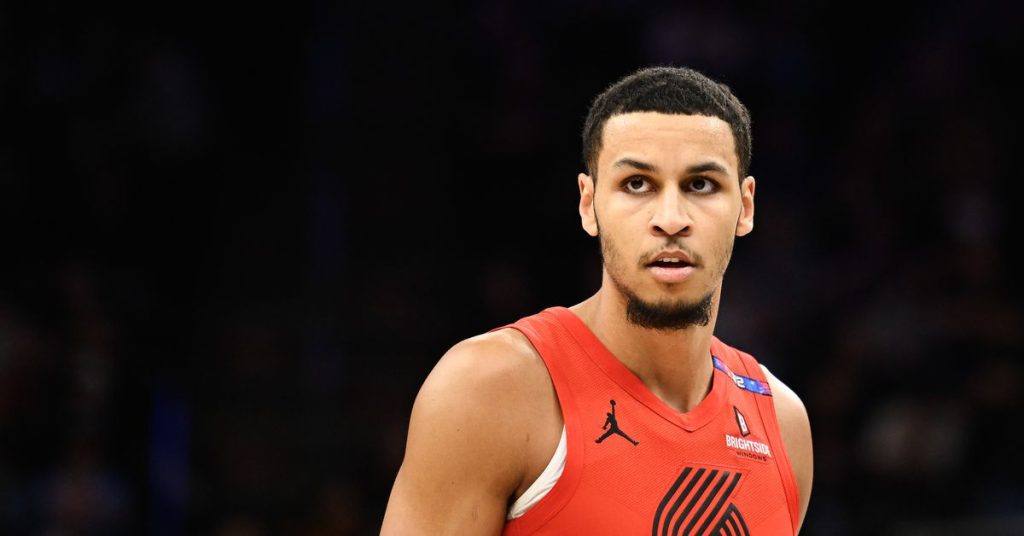The Portland Trail Blazers have made notable progress in enhancing their depth over the last three seasons. While the team lacks a standout star, it features a roster with skilled players who offer versatility at various positions.
Kris Murray, a former first-round draft pick, is expected to find limited playing time at the start of the season, as the wing and forward roles are occupied by other players with stronger claims to minutes. Deni Avdija, Toumani Camara, Shaedon Sharpe, Jerami Grant, and Matisse Thybulle are anticipated to see action before Murray.
However, Murray, who will turn 25 later this month, showed positive development last season. Although his stats didn’t fully capture his improvements, he demonstrated the ability to move effectively without the ball, finish at the rim, and guard multiple positions.
He averaged 4.2 points with a shooting percentage of 41.9 from the field and 22.5 from three-point range, in addition to 2.6 rebounds, 1.0 assist, and 0.5 steals in 15.1 minutes of play. Among forwards, he ranked ninth in offensive rebounding, collecting 7.3 percent of Portland’s missed shots.
When Murray was on the court, the Blazers had a +1.1 point difference. Specifically, they were +3.3 in offensive rebounds, while opponents performed worse by 4.4 points, and their effective field goal percentage dropped by 4.0 percent.
Unfortunately, Murray’s inconsistent three-point shooting is currently limiting his chances for more playing time.
Murray’s Game
Selected with the 23rd overall pick in 2023, Murray entered the league with far less hype compared to his twin brother Keegan, who was picked fourth by the Sacramento Kings the previous year. Along with Scoot Henderson, Murray was one of four Blazers selected during the 2023 draft night, while Rayan Rupert and Toumani Camara—acquired in the Damian Lillard trade—were second-round picks.
Hailing from the University of Iowa, the 6’8″ Murray was viewed similarly to Keegan but without the elite scoring ability. He exhibited mobility and length, using opportunistic plays to add value on offense.
Three-point Shooting
Despite reports of improved three-point shooting at the Blazers’ practice facility, this ability has not consistently transitioned to the NBA. Last season, his three-point shooting was a low 22.5 percent on 1.7 attempts per game, ranking him 101st among forwards. His corner shooting was a little better at 25.9 percent, allowing him to climb to 100th among forwards, but still well below acceptable levels.
In today’s NBA, forwards and wings who lack facilitation skills must consistently shoot at least 35 percent from beyond the arc, a rate that his brother Keegan typically maintains. Falling short of this benchmark makes it easier for defenses to ignore him, leading to congested paint areas that hinder driving opportunities.
What If Murray Starts Converting?
If Kris Murray can improve his three-point shooting to around 35 percent on a decent volume of shots (three to four attempts per game), it could result in an intriguing situation for the Blazers. Coupled with his defensive awareness and basketball intelligence, a reliable long-range threat would necessitate more playing time for him.
While he may not be on par defensively with Matisse Thybulle, Murray’s outside shooting could make Thybulle more expendable. Thybulle enters this season with a player option and will be an unrestricted free agent next summer unless the Blazers either extend or trade him beforehand.
Conclusion
If Murray continues to struggle with his three-point shooting, he may securely remain in the NBA but could find himself relegated to a deep rotation role. Conversely, if he begins to shoot like his twin brother, the Blazers will face decisions about extending him next summer.
Murray excels in various aspects of the game, including defense across multiple positions, offensive movement without the ball, rebounding, and finishing at the rim. He doesn’t need to be a primary ball handler, as the current roster is filled with players who can create and advance the ball.
Effective two-way wings and forwards are vital for an NBA team’s success, particularly during the NBA Playoffs. The ability to shoot from long range at a better rate than what Murray has displayed will be crucial for his continued role.
The fact he can shoot well in practice suggests his shooting mechanics aren’t faulty. The hope is that Murray can resolve his game-time jitters soon, as the Blazers will need to make decisions regarding his career.



